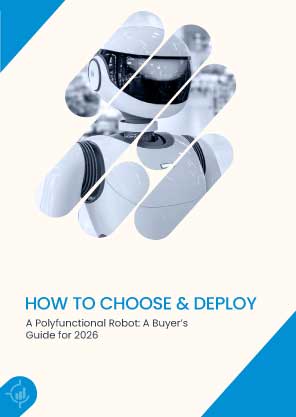or call: +1 (845) 347-8894

or call: +1 (845) 347-8894

The year 2026 is shaping up to be a landmark moment for enterprise automation. After years of fragmented robotics deployments and proof-of-concept experiments, the industry is finally pivoting toward systems that can do more than one isolated task.
Leaders across technology, manufacturing, healthcare, logistics, and data infrastructure are now turning their attention to the polyfunctional robot. These next-generation systems are built to handle multiple activities across operations, adapt to changing workflows, and integrate seamlessly with AI-driven processes.
The global advanced robotics market size is calculated at USD 53.74 billion in 2025 and is forecasted to reach around USD 280.01 billion by 2034, accelerating at a CAGR of 20.13% from 2025 to 2034.
The question is no longer whether robotics fits into the business roadmap. The real challenge is how to select the right technologies, deploy them effectively, and tie them directly to revenue and efficiency outcomes.
A polyfunctional robot is fundamentally different from the traditional single-purpose robotic systems many enterprises are familiar with. Instead of performing one repetitive motion or supporting a narrow workflow, a polyfunctional robot is designed to handle multiple roles across an operation without needing dedicated hardware for each task. Think of it as a unified automation asset that can inspect, lift, transport, analyze, and respond to dynamic environments, all through an AI-enabled control layer.
Asia installed 74% of all newly deployed industrial robots, with China alone accounting for ~54% of global installations.
This evolution matters because the old model of deploying siloed robots for isolated tasks no longer fits the pace or complexity of modern enterprise operations. Organizations need systems that adapt quickly, learn continuously, and support cross-functional teams. A polyfunctional robot brings this flexibility by blending mobility, manipulation, perception, and data intelligence into a single platform. It can shift between departments, scale with demand, and integrate with existing digital infrastructure.
For executive teams, this means greater business agility, better resource utilization, and a stronger foundation for long-term automation strategies. In essence, polyfunctional robots have become strategic assets rather than operational add-ons.
Several forces are converging to make 2026 a turning point for enterprise robotics. First, AI models have matured to the point where robots can understand environments, predict outcomes, and self-correct in real time. This shift removes the dependency on rigid programming and allows a polyfunctional robot to perform diverse tasks with a level of autonomy that was not possible even a few years ago.
Second, hardware costs are declining while performance continues to accelerate. High-precision sensors, edge computing modules, and advanced actuators have become more affordable, enabling enterprises to adopt multi-capability systems without stretching capital budgets. At the same time, cloud-based control platforms have eliminated the need for heavy on-premise infrastructure.
Finally, industries across the United States are under pressure to improve productivity, address growing labor shortages, and strengthen operational resilience. This combination of technological maturity and business urgency has created the perfect environment for widespread adoption of polyfunctional robots. In 2026, the organizations that embrace these systems early will gain measurable advantages in efficiency, cost savings, and innovation velocity.
For C-level leaders, the value of a polyfunctional robot goes far beyond operational automation. It directly contributes to enterprise growth, cost optimization, and competitive positioning. By consolidating multiple workflows into a single intelligent system, organizations can significantly reduce redundancy, shrink process bottlenecks, and streamline labor-intensive activities. This creates a more predictable and scalable operational environment that supports both short-term productivity and long-term transformation.
The financial impact is equally compelling. A polyfunctional robot helps reduce the total cost of ownership by replacing separate single-task machines, minimizing downtime, and improving asset utilization. It also supplements workforce capacity, allowing teams to focus on higher-value tasks while automation handles repetitive or hazardous work. Instead of replacing employees, these systems enhance their capabilities and create a more resilient human-machine partnership.
From a strategic standpoint, adopting innovative technology solutions like polyfunctional robotics enables companies to respond faster to market changes, support continuous improvement, and differentiate through smarter, data-driven operations. Leaders who invest in these systems today are positioning their organizations for stronger margins, sustainable growth, and a future-ready competitive edge.
Selecting the right polyfunctional robot is a major strategic commitment, and the decision should go far beyond evaluating features or comparing price points. As companies enter 2026 with tighter margins and higher expectations for operational efficiency, leaders must take a structured approach to ensure every investment aligns with long-term business objectives.
Start by clarifying what the organization wants to achieve. Is the goal to reduce labor dependency, improve throughput, enhance quality control, or expand capacity without increasing headcount? A polyfunctional robot should map directly to measurable business outcomes, not just technical improvements.
Look for systems that combine mobility, manipulation, sensing, and AI-driven decision making. The robot should handle diverse tasks without requiring manual reconfiguration. Assess how it performs in unpredictable environments and whether it can adapt to shifting workflows.
A polyfunctional robot must fit into your existing digital ecosystem, including ERP platforms, IoT networks, warehouse systems, and analytics tools. Seamless integration reduces deployment time and improves data flow across the organization.
Automation needs grow over time. Choose a system that can expand across departments or locations, support new use cases, and receive continuous updates. Scalability ensures long-term ROI instead of short-term gains.
Robots must meet regulatory requirements and support strong safety protocols. Evaluate built-in safeguards, redundancy features, and compliance with industry standards. This is especially important in healthcare, logistics, and manufacturing.
The real power of a polyfunctional robot lies in the data it captures. Ensure the platform provides insights on performance, predictive maintenance, workflow efficiency, and operational patterns. Data-driven automation increases both transparency and strategic decision-making.
Choose partners that have proven reliability, long-term product roadmaps, strong customer support, and experience with enterprise-scale deployments. A capable ecosystem minimizes risk and speeds up adoption.
Factor in training, software subscriptions, maintenance, updates, and integration costs. A polyfunctional robot may cost more initially, but can deliver a higher ROI if it replaces multiple single-purpose systems.
When executives evaluate these areas with a structured lens, they ensure the chosen solution aligns with both immediate needs and future innovation goals. This approach transforms automation from a tactical purchase into a powerful enabler of enterprise growth.
Choosing how to deploy a polyfunctional robot is just as important as selecting the robot itself. The deployment model determines speed of adoption, cost structure, data control, and long-term scalability. For leadership teams, the goal is to match the deployment approach with business priorities while ensuring that the automation environment remains flexible and secure.
On-premise deployment offers maximum control, making it ideal for sectors with strict regulatory or data sensitivity requirements. However, cloud-controlled models provide faster updates, easier scaling, and lower infrastructure maintenance. Many organizations are now choosing hybrid setups that use the cloud for intelligence and on-premise systems for critical data.
A polyfunctional robot can operate with varying levels of oversight. Fully autonomous models are suited for stable, predictable environments. Human-supervised systems are better for dynamic workflows where decisions need real-time validation. Executives should align autonomy levels with risk tolerance and operational complexity.
Most enterprises will operate a mix of robots with different capabilities. A polyfunctional robot can serve as the central automation asset, coordinating with single-purpose robots or AI tools. This model supports cross-departmental scaling and drives a more integrated automation strategy.
Subscription-based RaaS offerings allow companies to access advanced robotics without a heavy upfront investment. This model is gaining traction in logistics, manufacturing, and healthcare, where demand fluctuates. RaaS also simplifies upgrades and reduces long-term maintenance commitments.
By selecting the right deployment model, companies can accelerate adoption, control costs, and ensure their polyfunctional robot delivers maximum business value. It becomes easier to align robotics with enterprise-wide goals while maintaining flexibility for future growth.
Deploying a polyfunctional robot requires careful planning, cross-functional alignment, and a clear understanding of operational goals. For C-level executives, the deployment process is not just a technical rollout but a business transformation initiative. The following structured playbook outlines how to approach deployment in a way that minimizes disruption and maximizes return on investment.
Begin by identifying the workflows where a polyfunctional robot will create the highest value. Assess current inefficiencies, labor-intensive activities, and areas that can benefit from precision and consistency. Prioritize use cases based on measurable business impact.
Launch a controlled pilot to validate performance. Establish KPIs such as cycle time reduction, accuracy improvements, throughput gains, and cost savings. Pilots help refine expectations and build internal confidence before scaling.
Prepare the physical and digital environment. This includes connectivity, safety zones, data integration points, power requirements, and IoT sensors. A polyfunctional robot performs best when the environment is optimized for automation.
Successful deployment depends on people as much as technology. Train teams to collaborate with the robot, interpret analytics, and adjust workflows. Clear communication reduces resistance and encourages adoption across the organization.
Ensure the deployment meets regulatory requirements and follows internal governance policies. Validate cybersecurity protections, access controls, encrypted data flows, and vendor security certifications.
After pilot success, deploy the polyfunctional robot across departments or locations. Continuously monitor performance and use collected data to optimize workflows. Regular updates and feedback loops help sustain long-term value.
This structured deployment approach allows enterprises to move confidently from testing to enterprise-wide automation, ensuring that the polyfunctional robot becomes a reliable and scalable asset in the organization’s growth strategy.
Even with strong planning, deploying a polyfunctional robot comes with challenges that can slow adoption or limit performance. For C-level executives, anticipating these obstacles early makes it easier to protect timelines, budgets, and expected ROI.
Robotics projects often fail when IT teams and operations leaders prioritize different outcomes. The solution is a unified roadmap that includes shared KPIs, governance frameworks, and consistent communication between departments. Aligning both groups from day one ensures smoother integration and sustained adoption.
Some organizations attempt to tailor every workflow before the system is even live. This creates delays and increases complexity. Instead, start with modular configurations. Allow the polyfunctional robot to learn and adapt before making extensive customizations.
Integrating robotics with ERP systems, cloud platforms, and data lakes can be more demanding than expected. Companies should involve experienced integration partners and conduct early architecture assessments to avoid unplanned delays.
Employees may resist automation due to uncertainty or fear of job displacement. Leaders can mitigate this by positioning the polyfunctional robot as a tool that supports employees rather than replaces them. Training programs, transparent communication, and clear role evolution plans help build trust.
Deployments often stall because teams are unsure how to measure progress. Establishing KPIs such as cycle times, accuracy rates, downtime reduction, and cost impacts provides clarity and accelerates improvement.
When leaders recognize and plan for these challenges, they can turn potential obstacles into opportunities for a more disciplined and effective automation rollout. Proactive decision making ensures the polyfunctional robot delivers measurable business value rather than becoming another underutilized technology investment.
As organizations prepare for the next phase of digital transformation, the question is no longer whether robotics should play a role but how rapidly leaders can adopt systems that move the business forward.
The polyfunctional robot stands out as one of the most impactful investments available to enterprises in 2026 because it consolidates multiple capabilities into a single, adaptable automation platform. It strengthens operational resilience, enhances workforce productivity, and creates the foundation for long-term efficiency gains.
Delaying adoption carries significant risk. Competitors that embrace advanced robotics will achieve faster cycle times, lower operating costs, and stronger innovation capacity. They will also build a data advantage that compounds over time. By contrast, companies that move slowly may struggle to catch up as automation becomes a standard expectation across industries.
For C-level executives, the path forward is clear. A thoughtful approach to selecting and deploying a polyfunctional robot can unlock meaningful business value and position the organization for sustained growth. The leaders who take action now will define the next generation of operational excellence and set the pace for their industries.
Measuring return on investment for a polyfunctional robot requires more than calculating cost savings or productivity improvements. Executives should look at both direct and indirect impacts to understand the full value these multi-capability systems bring to the enterprise. The “warehouse robotics” segment alone is projected at USD 6.51 billion in 2025, growing to USD 17.98 billion by 2032 (CAGR ~15.6%).
1. Direct Operational Gains – Track improvements in cycle times, error reduction, throughput, and task completion rates. These metrics show how the robot enhances day-to-day operations.
2. Labor Efficiency and Workforce Capacity – Evaluate how the robot frees teams from repetitive tasks, reduces overtime, and reallocates human skills to higher-value work. These shifts can significantly improve workforce productivity.
3. Reduction in Technology Redundancy – Since one polyfunctional robot can replace multiple single-purpose machines, measure the cost savings from retiring outdated systems and lowering maintenance expenses.
4. Data-Driven Decision Making – Robots generate valuable insights on performance, patterns, and bottlenecks. Over time, this data improves forecasting, resource planning, and strategic decision-making.
5. Enterprise Resilience and Scalability – Assess how the robot supports business continuity, handles fluctuating demand, and scales across departments or locations.
By measuring ROI through these broader dimensions, leaders gain a more accurate understanding of how robotics contributes to long-term competitiveness and organizational growth.
1. Does this investment support our three to five-year growth strategy?
A robot should reinforce expansion plans, operational goals, and the company’s future infrastructure, not just solve short-term challenges.
2. Can our existing systems support the level of data exchange required?
Since a polyfunctional robot relies heavily on real-time data, leaders should confirm that current systems can handle the required connectivity, analytics, and integration.
3. Which workflows will see the fastest and most meaningful ROI?
Clear prioritization helps avoid scattered deployments and ensures fast, measurable wins that build organizational confidence.
4. How prepared is our workforce for human-machine collaboration?
Training requirements, role adjustments, and cultural readiness play a major role in the success of automation initiatives.
5. Are we selecting a partner who can support us through scaling?
A strong vendor ecosystem reduces long-term friction and ensures the business can grow without being limited by technology constraints.
To participate in our interviews, please write to our IntentTech Media Room at info@intentamplify.com




